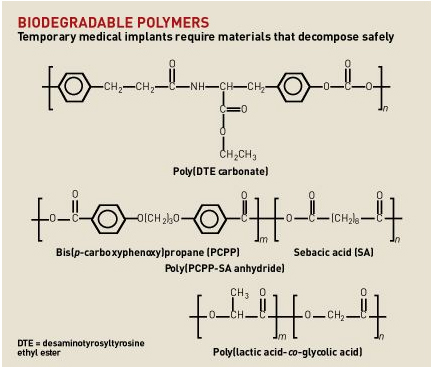Polymers are synthetic
and natural macromolecules composed of smaller
units called monomers. Many synthetic polymers
are produced and utilized because they are
resistant to chemical and physical degradation.
These polymers resistant to degradation present
disposal problems when their usefulness ceases.
Research has shown that substitution of natural
monomers into synthetic polymers produces
polymers that are more easily biodegraded.
A biodegradable polymer
is a polymer in which the degradation results
from the action of naturally occurring microorganisms
such as bacteria, algae or fungi. These biodegradable
polymers are largely used in medical application
where they undergo degradation by chemical
hydrolysis.
Polymers prepared from glycolic acid and lactic acid has found a multitude of uses in the medical industry, beginning with the biodegradable sutures first approved in the 1960s. Since that time, diverse products based on lactic and glycolic acid�and on other materials, including poly(dioxanone), poly(trimethylene carbonate) copolymers, and poly (  -caprolactone) homopolymers and copolymers �have been accepted for use as medical devices. In addition to these approved devices, a great deal of research continues on polyanhydrides, polyorthoesters, polyphosphazenes, and other biodegradable polymers.
-caprolactone) homopolymers and copolymers �have been accepted for use as medical devices. In addition to these approved devices, a great deal of research continues on polyanhydrides, polyorthoesters, polyphosphazenes, and other biodegradable polymers.
Some examples of the biodegradable polymers are shown below.

• There may be a variety
of reasons, but the most basic begins with
the physician's simple desire to have a device
that can be used as an implant and will not
require a second surgical
intervention for removal.
• Besides eliminating
the need for a second surgery, the biodegradation
may offer other advantages .
For example, a fractured bone that has been
fixated with a rigid, nonbiodegradable stainless
implant has a tendency for refracture upon
removal of the implant. Because the stress
is borne by the rigid stainless steel, the
bone has not been able to carry sufficient
load during the healing process. However,
an implant prepared from biodegradable polymer
can be engineered to degrade at a rate that
will slowly transfer load to the healing bone.
• Another exciting use for which
biodegradable polymers offer tremendous potential
is as the basis for drug delivery
, either as a drug delivery system
alone or in conjunction to functioning as
a medical device.
• Biodegradable materials may be
the only option for some potential applications.
For example, reconstructing functioning
blood vessels requires materials
that degrade in the body, because nondegradable
scaffolds occupy too much volume to allow
tissues to regrow completely.
The general criteria for selecting a polymer
for use as a biomaterial are to match the
mechanical properties and
the time of degradation to the needs of the
application. The ideal polymer for a particular
application would be configured so that:
- It has mechanical properties that match
the application, remaining sufficiently
strong until the surrounding tissue has
healed.
- It does not invoke an inflammatory or
toxic response.
- It is metabolized in the body after fulfilling
its purpose, leaving no trace.
- It is easily processable into the final
product form.
- It demonstrates acceptable shelf life.
- It is easily sterilized.
Significant commercial use of biodegradable
polymers:
Sutures.
Of the total medical biodegradable
market, this is a mature area expected to
grow rapidly in the future. About 125 million
synthetic bioabsorbable sutures are sold each
year in the United States. They are divided
into braided and monofilament categories.
Braided sutures
are typically more pliable than monofilament
and exhibit better knot security when the
same type of knot is used . Monofilament
sutures are more wiry and may require
a more secure knot. Their major advantage
is that they exhibit less tissue drag, a characteristic
that is especially important for cardiovascular,
ophthalmic, and neurological surgeries.
There are eight objective and three subjective
parameters for suture selection
based on criteria such as tensile
strength, strength retention, knot security,
tissue drag, infection potential, and ease
of tying. SYNTHETIC
degradable sutures have been available commercially
since the 1970s. Originally made from polyglycolic
acid (PGA), early versions of the products
degraded and lost their mechanical strength
in just two to four weeks--too fast for some
applications. To broaden the range of uses,
alternative sutures were
made from copolymers of PGA and a more hydrophobic
compound, polylactic acid (PLA). PLA's hydrophobicity
limits the extent of water uptake in the copolymer,
which in turn reduces the rate at which the
polymer backbone is hydrolyzed relative to
PGA.
